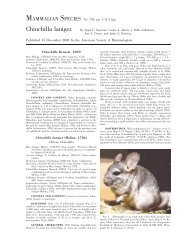Capra ibex (Artiodactyla: Bovidae)
Capra ibex (Artiodactyla: Bovidae)
Capra ibex (Artiodactyla: Bovidae)
You also want an ePaper? Increase the reach of your titles
YUMPU automatically turns print PDFs into web optimized ePapers that Google loves.
2 MAMMALIAN SPECIES 830—<strong>Capra</strong> <strong>ibex</strong><br />
Turocapra de Beaux, 1949:17. Type species <strong>Capra</strong> pyrenaica<br />
Schinz, 1838, by original designation; described as a<br />
subgenus of <strong>Capra</strong> Linnaeus, 1758.<br />
Hilzheimeria Kretzoi and Kretzoi, 2000:164. Replacement<br />
name for Turus Hilzheimer in Hilzheimer and Heck,<br />
1916, under the mistaken assumption that Turus was<br />
preoccupied by Turus Gloger, 1841:303 (an incorrect<br />
subsequent spelling of Turdus Linnaeus, 1758 [Aves]).<br />
CONTEXT AND CONTENT. Order <strong>Artiodactyla</strong>, suborder<br />
Ruminantia, infraorder Pecora, family <strong>Bovidae</strong>, subfamily<br />
Caprinae, tribe Caprini (Simpson 1945). There are differing<br />
opinions as to the number of species within the genus<br />
<strong>Capra</strong>. Haltenorth (1963) recognized only 2 species (hircus<br />
and falconeri), whereas Heptner et al. (1961) recognized 9.<br />
Grubb (2005) listed the following species: C. caucasica, C.<br />
falconeri, C. hircus, C. <strong>ibex</strong>, C. nubiana, C. pyrenaica, C.<br />
sibirica, and C. walie. In addition to these 8 species,<br />
Heptner (1961) included cylindricornus, which Grubb<br />
(2005) listed as a subspecies of C. caucasica.<br />
<strong>Capra</strong> <strong>ibex</strong> Linnaeus, 1758<br />
Alpine Ibex<br />
[<strong>Capra</strong>] Ibex Linnaeus, 1758:68. Type locality ‘‘[I]n Wallesiae<br />
praeruptis inaccessis,’’ Alps of Valais, Switzerland.<br />
<strong>Capra</strong> alpina Girtanner, 1786:224. Type locality ‘‘Alpes qui<br />
s’étend du Dauphiné jusqu’en Styrie [5 Alps that extend<br />
from the Dauphiné to the Styria];’’ substitute for <strong>ibex</strong>.<br />
Aegoceros <strong>ibex</strong>: Pallas, 1811:224. Part (see Lydekker<br />
1913:141); name combination.<br />
Ibex alpinus: Gray, 1847:59. Name combination.<br />
Ibex europea Hodgson, 1847:700. Type locality ‘‘Europe.’’<br />
<strong>Capra</strong> <strong>ibex</strong> graicus Matschie, 1912:120. Type locality<br />
‘‘Valsavaranche,’’ southwestern Aosta, Graina Alps,<br />
Italy.<br />
CONTEXT AND CONTENT. Context as for genus. <strong>Capra</strong> <strong>ibex</strong> is<br />
monotypic.<br />
NOMENCLATURAL NOTES. We used the taxonomy of<br />
Grubb (2005), but because all forms in the genus <strong>Capra</strong><br />
are interfecund, the taxonomy is still debated (Grubb 2005;<br />
Manceau et al. 1999; Schaller 1977; Shackleton 1997).<br />
Designation of different species generally is based on<br />
differences in morphology, behavior, geographic isolation,<br />
and environmental conditions in which the different forms<br />
live (Gauthier et al. 1991). Classifications based solely on<br />
morphological characters are the most controversial and<br />
are not always supported by allozyme (Hartl et al. 1990,<br />
1992) or mitochondrial DNA (Manceau et al. 1999)<br />
studies. <strong>Capra</strong> is Latin for a goat, and <strong>ibex</strong> is Latin for a<br />
kind of goat.<br />
DIAGNOSIS<br />
<strong>Capra</strong> is distinguished from Ovis by the presence of<br />
preorbital, inguinal, and pedal glands; absence of facial<br />
glands; a potent body odor; beard in males; and presence of<br />
a callus on the knee (Schaller 1977). Total length of adult<br />
male C. <strong>ibex</strong> is 150 cm, height at withers is 93 cm, and body<br />
mass is 67–117 kg, reaching a maximum in November before<br />
rut and a minimum in April after rut. It is about the same<br />
size as C. hircus aegagrus (150 cm, 95 cm, 70–80 kg)<br />
compared to 171 cm, 110 cm, and 130 kg for C. sibirica;<br />
170 cm, 115 cm, and 109 kg for C. falconeri; and 165 cm,<br />
109 cm, and 96 kg for C. caucasica (Heptner et al. 1988;<br />
Schaller 1977).<br />
<strong>Capra</strong> <strong>ibex</strong> (Fig. 1) has short, broad facial features, the<br />
same as C. sibirica, whereas C. nubiana, C. walie, C.<br />
falconeri, and C. caucasica have narrow features similar to<br />
those of C. hircus (Schaller 1977). Horns of C. <strong>ibex</strong> are<br />
scimitar shaped with a relatively flat anterior surface broken<br />
by prominent transverse ridges, similar to those of C.<br />
caucasica, C. sibirica, C. nubiana, and C. walie. In contrast,<br />
horns of C. falconeri are twisted in a spiral, and horns of C.<br />
pyrenaica are curved out, up, and then back, inward and<br />
then up again, and have a sharp posterior keel. Length of<br />
horns of C. <strong>ibex</strong> is 75–98 cm compared with 100–148 cm in<br />
C. sibirica, 55–161 cm in C. falconeri, 110–140 cm in C.<br />
hircus, and 48–118 cm in C. caucasica (Schaller 1977). All<br />
species of <strong>Capra</strong> have light-colored abdomens, dark dorsal<br />
stripes from nape to rump, and beards on the chin; females<br />
do not have beards. C. <strong>ibex</strong> is the least colorful of the <strong>Capra</strong><br />
species; it has gray-brown pelage, darker on chin, upper<br />
portion of throat, and underparts, and blackish below and<br />
along anterior surface above (Harper 1945). C. <strong>ibex</strong> does not<br />
have prominent markings on its forelegs, in contrast to C.<br />
nubiana and C. sibirica (Schaller 1977).<br />
GENERAL CHARACTERS<br />
Dimorphism among <strong>Capra</strong> <strong>ibex</strong> is striking; sexes mainly<br />
differ in body mass and horn dimensions (Couturier 1962;<br />
Giacometti et al. 1997; Michallet et al. 1996; Nievergelt<br />
1966, 1978; Ratti 1981; Ratti and Habermehl 1977). In<br />
Graubünden, Swiss Alps, in October, the gutted weight of<br />
adult females was about 50% of that of adult males (26–<br />
36 kg, n 5 1,281 versus 59–80 kg, n 5 357). In the same<br />
colony, differences in length of body and shoulder height<br />
between sexes are about 22% (121–141 cm versus 149–<br />
171 cm and 73–84 versus 90–101 cm) and for thoracic<br />
circumference, about 30% (76–88 versus 100–114 cm—<br />
Giacometti et al. 1997).<br />
Populations of different origins have slightly different<br />
body sizes. Males older than 9 years in Gran Paradiso<br />
National Park, Italy, have a body length of 160.8 6 5.0 cm<br />
(mean 6 SD), shoulder height of 97.6 6 1.9 cm, and thoracic

















